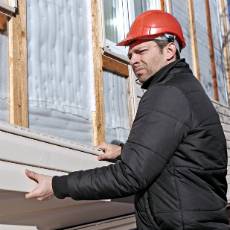If you're trying to figure out how to install a vent in vinyl siding, you'll be happy to know that the job isn't as complicated as it sounds. Most people trying to learn how to install a vent in vinyl siding are trying to create a working, safe air duct for their clothes dryers. A properly installed vent ensures that events such as lint fires or carbon monoxide buildup don't occur when the dryer is in use. It's for this reason that you should speak with a siding contractor to make sure that you're doing the job properly.

The best time to install a vent in your home is when you install siding. If your home already has siding installed, it can still be easily done. A contractor who's familiar with working with vinyl would be ideal, but someone with decent handyman skills can figure out how to install a vent in vinyl siding very easily. Your first step is to locate the most direct route for the vent. You'll want to find the path that has the least amount of turns. You must measure the length of the run, and then buy that amount of duct. Make sure that you purchase enough straight duct to complete the job, getting a little extra if necessary. You'll need to get the fittings and the outdoor cap as well. When choosing a material for your duct, select either aluminum or galvanized steel, but don't get both. Next, step outside and check out the area where you've decided to install the vent. If everything looks correct, return to the inside of your house and mark the location for the vent. You can plan the exact duct route at this point.
 Next, go outside and drill a hole with a diameter of about 4.25-inches into the vinyl where you want to install the duct. A bimetal hole saw can handle this job perfectly. Next, take a vinyl surface-mounting block and screw it into the hole. Vinyl surface mounting blocks are the best choice for these types of jobs because they create the firm seal that your dryer needs. You'll then take a vent cap, slide it into the hold and screw it into place. Caulk the edges to create a tight seal.
Next, go outside and drill a hole with a diameter of about 4.25-inches into the vinyl where you want to install the duct. A bimetal hole saw can handle this job perfectly. Next, take a vinyl surface-mounting block and screw it into the hole. Vinyl surface mounting blocks are the best choice for these types of jobs because they create the firm seal that your dryer needs. You'll then take a vent cap, slide it into the hold and screw it into place. Caulk the edges to create a tight seal.
Take the ducts and run them from your dryer to where you've installed the vent. Although you can use either aluminum or galvanized steel ducts, many contractors prefer the galvanized steel versions because their smooth texture helps prevent the lint flying towards the vent from being caught in any grooves. Place one of the duct lower elbows onto the dryer and one of the upper elbows onto the inside of the vent cap. Take the crimped ends of the galvanized-steel duct and slide it into the fitted end. You'll then use as many pieces as you need to connect it all the way through from the dryer to the vent cap. Finally, seal the seams with metal foil tape to get a strong seal.
If you're doing the install on a home you're in the process of building, you'll have to include expenses such as siding prices in your final tally. Check with a contractor to get a siding estimate or check out Reply! to get an idea of what typical siding costs will run you. Figuring out how to install a vent in vinyl siding is easy. Doing it properly is the part that will take some effort, but once you're done, you'll have a beautifully functioning vent.












Write a Comment